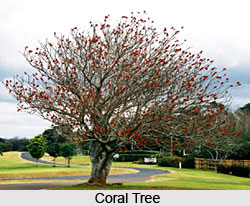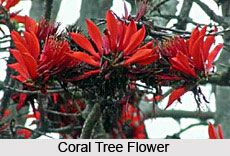 Coral Tree`s scientific name is `Erythrina Indica`. The tree came from the family of `Leguminosae` and sub family of `Papilionacece`. In Hindi Language, this is known in as many names as the `Mandara`, `Panjira`, `Dholdhak`, `Pangri`, `Pharad` or `Dadap`. The Tamil people call it as `Kalyana Murungai`, `Maruka` or `Mulu Murungu`. In Bengali Lanuage, this tree is well known as `Palita Mundar` and `Rakta Madar`. It is one of India`s very own trees that grow wild along the seaside and in some inland districts of deciduous forests. However, in the other places, it escapes from extensive cultivation and grows self-sown.
Coral Tree`s scientific name is `Erythrina Indica`. The tree came from the family of `Leguminosae` and sub family of `Papilionacece`. In Hindi Language, this is known in as many names as the `Mandara`, `Panjira`, `Dholdhak`, `Pangri`, `Pharad` or `Dadap`. The Tamil people call it as `Kalyana Murungai`, `Maruka` or `Mulu Murungu`. In Bengali Lanuage, this tree is well known as `Palita Mundar` and `Rakta Madar`. It is one of India`s very own trees that grow wild along the seaside and in some inland districts of deciduous forests. However, in the other places, it escapes from extensive cultivation and grows self-sown.
Description of Coral Tree
Coral Trees make their appearance very prominent amongst the bare branches. The tree is a large and elegant one and even when it is leafless, it looks very gorgeous indeed. The normal height of this tree is about 18 m except some places where it never crosses the limit of 7.5 m. This is very much popular amongst the people as a garden or park tree because it starts flowering from the height of only 3 or 4 m.
The twigs of the `Coral Tree` are normally grey, twisted and uneven and the flower stems spread out from their ends. They are also very smooth and a deep red in colour. The flowers have a lot of twists and the buds are surrounded by a good 22 or 25cm of the stem. A brownish case wraps the unopened flower and allows two of its five fragments to extend like funny "ears". In spite of having no scent, the flowers of the tree are very much popular among the birds. The Crows, Mynahs, Rosy pastors, Babblers, Parakeets, as well as a lot of bees and wasps complete the list of its most dedicated admirers. The flowers become very easily fertilized by their adoration. The big pods begin to form just after the flowering. When they appear, they are green and with the course of time they turn black. With a length of 15 to 30 cm, they contain up to a dozen smooth egg-shaped seeds that are brown, red or purple in colour. The pod is slandered between each seed. The young trees conserve their leaves before flowering. Some other trees attain new leaves when they are still in flower. The leaves are composed of three large leaflets and in a short stem; the last one is the largest.
Usage of Coral Tree in India
The Indian country people use Coral tree to plunder the cattle and other animals and they also plant it as a hedge around the gardens. Because of having a quick growth and suitable bark, this tree is also used as a support of pepper and grape vines. During the summer, the crowded flora provides deep shade to the vines and keeps them humid. In the winter, the leaves of the tree fall down and the vines receive the sun they required.
 People can also eat the new leaves in curries and the adult leaves can make very useful cattle fodder. Though the timber of the tree is light and soft, they are durable and in fulfilling such purposes where heavy woods are unsuitable, they can provide you the best service. A strong scented dye can be obtained from the flowers of this tree. It is strongly believed that the Hindu God, Lord Krishna stole the flowers of the `Coral Tree` from Lord Indra`s garden.
People can also eat the new leaves in curries and the adult leaves can make very useful cattle fodder. Though the timber of the tree is light and soft, they are durable and in fulfilling such purposes where heavy woods are unsuitable, they can provide you the best service. A strong scented dye can be obtained from the flowers of this tree. It is strongly believed that the Hindu God, Lord Krishna stole the flowers of the `Coral Tree` from Lord Indra`s garden.
Species of Coral Tree
One can find a large number of species of `Erythrina`. Most of them are terrific for their brilliant red flowers that borne during the leafless period of the tree. The common species on the riversides is `Erythrina Stricta`, which is very similar to `Erythrina Variegata` except some small differences in the calyx. In the South Indian hills `Erythrina Subumbrans, known as `Dadap,` is widely used as a shade tree on tea estates. It is almost evergreen and grows very rapidly to the extent of 15 m. This tree is also composed of three large leaflets on a long stem and the leaves are very much similar to those of `Erythrina Variegata`. However, the flowers are smaller and less flashy.



















